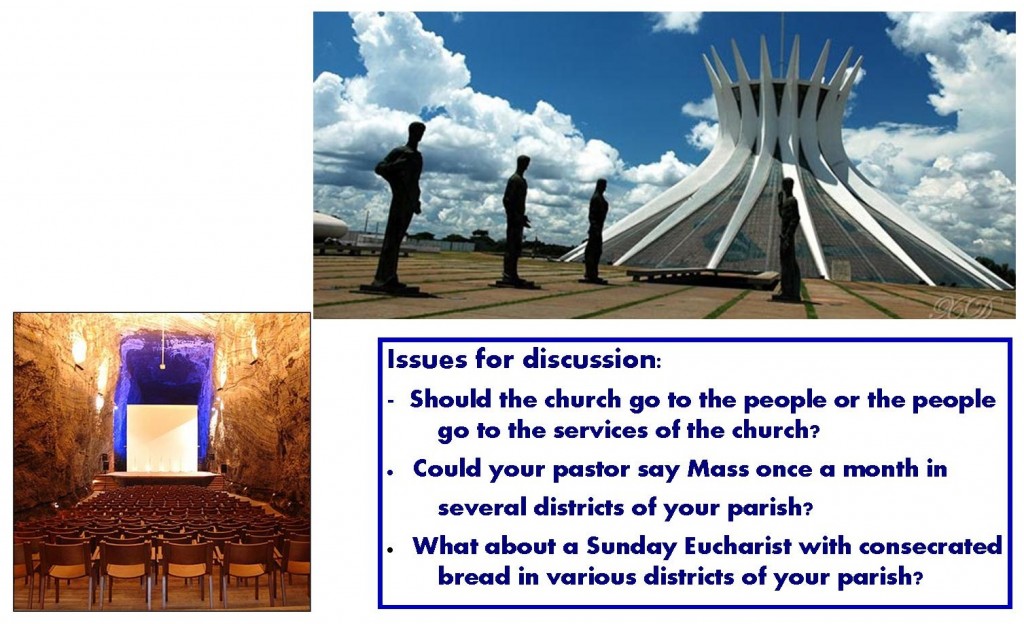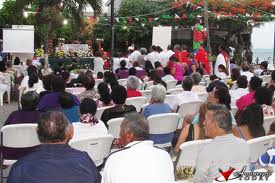4 - NEIGHBORHOOD CHURCHES Images of the Future Church

Dear U.S. friend, Our pastor believes that the church should go to the people rather than wait for the people to come to church. This is why we have neighborhood Masses and local churches. Twice a week our pastor says Mass in the open air, or about once a month in every parish district. Although a district may have its own church or chapel, our pastor prefers to celebrate the Eucharist in a different place each time, a street corner or alley, in a court yard or between apartment buildings, because the purpose is to reach different people each time. Since it is the people of the neighborhood who decide where they want to have Mass, nobody actually knows in advance the exact location; it is the members of house-churches who must announce it by going from door to door. Even before the beginning of the Mass and from one or two street blocks away one can hear the singing going on, amplified by a loud speaker; people don’t wait the arrival of the priest to start singing. The altar has been set up under an elevated tent, in case of rain, and many plastic stools put in place for the assembly. When the priest arrives, many people come to him to shake hands and exchange greetings. The pace of the Mass is leisurely. There is no choir as everybody sings, but there may be guitar music and a singing leader. The homily may be twice as long as on an average Sunday: it is more like a conversation or dialogue than the customary monologue. Through the Eucharistic prayer, the assembly is invited to join in various ways. The priests knows the prayers by heart, the people know the songs from memory, and all sing and pray from the heart. We also have neighborhood Sunday celebrations. Why don’t people just go to the main church? The reason is simple: the parish church is far away and people have no car; even if you have a car it is useless, as there is no parking in the streets around the church, because there is an open air market going on around it. We believe the church should go to the people; that’s why we have neighborhood churches. Traditional parishes are like restaurants: you go there, you don’t have to cook, you will be served, and you don’t have to do the dishes – you just pay. In neighborhood churches the community has to take care of all that. You want a place to meet? find it, and rent it! You want to sing? Invite musicians and volunteers to start the singing. You will need a few Eucharistic ministers: ask the pastor to nominate a few within your community. You need a coordinator and treasurer? Elect them. How? Write your own by-laws. And the preacher? Find a few in your house-churches; invite them to take courses in preaching and pay for it. And what about decorating the church and cleaning up? Create teams of volunteers. You will also need catechists to teach the children and prepare them for first communion and confirmation, although this may be done in conjunction with the parish. And visit the sick and the poor, and be ready to comfort the grieving and preside at funerals. The principle is clear: you want a church? Create one, and let the sky be the limits – of course with the approval and encouragements of the pastor. Our neighborhood Sunday celebrations are Eucharists with consecrate bread. You call them “celebrations without a priest.” Strange! Don’t you know that Jesus Christ is the only true priest of his church? In cultic Masses, you need a priest, a sacrifice, and a ritual, but not an assembly; a Mass in front of an empty church is the same – in terms of sacrifice – as a Mass before thousands. Strange again. “I urge you, brothers and sisters, in view of God’s mercy, to offer your bodies as a living sacrifice, holy and pleasing to God—this is your true and proper worship” (Romans 12:1). It would seem that the assembly should be part of it, and not just by saying Amen at appointed times. Sunday Eucharistic celebrations at the neighborhood churches usually attract about 100 to 150 participants; multiply this by five or ten and you get quite a big number of people who, most likely, would not have gone to the parish church. So Sunday celebrations in neighborhood churches are a real blessing and serve an obvious need. In Latin America there is one priest for about 7,000 to 10,000 Catholics. In poor neighborhoods, the ratio is probably around one for 50,000 or more, as priests and parishes are located in wealthy areas where there is a greater demand for their services. In the U.S. in 2005 there were 30,632 lay paid and 2,163 volunteer ecclesial ministers working at least twenty hours per week in parishes. That’s what money can do: you can “buy” or hire ten times more paid volunteers than unpaid ones. The opposite is true here: instead of hiring a religious education Director, we enlist scores of catechists; instead of paying for a music director and organist, we want everybody to sing by heart; and you can’t pay people to be missionaries, and that’s what our parish aims to be at heart. More on that in my next letter. |
 The Eucharist ends with the kiss of peace, people moving from person to person while the singing continues. These greetings mark the beginning of the party with sandwiches and soft drinks that may last half an hour, full of laughter and good humor. At the end, the plastic stools are piled up, the tent dismantled, and everything cleared within minutes. It is a true community Mass: the priest just arrives, as all the preparations in the open air are ready, the assembly is already singing. Two days later there will be another community Eucharist organized by a different neighborhood. All are welcome, the single mothers, the divorced and remarried, the cohabiting couples, and the religiously indifferent but curious Catholics and non-Catholics. It is a local image of the universal church of Christ.
The Eucharist ends with the kiss of peace, people moving from person to person while the singing continues. These greetings mark the beginning of the party with sandwiches and soft drinks that may last half an hour, full of laughter and good humor. At the end, the plastic stools are piled up, the tent dismantled, and everything cleared within minutes. It is a true community Mass: the priest just arrives, as all the preparations in the open air are ready, the assembly is already singing. Two days later there will be another community Eucharist organized by a different neighborhood. All are welcome, the single mothers, the divorced and remarried, the cohabiting couples, and the religiously indifferent but curious Catholics and non-Catholics. It is a local image of the universal church of Christ.